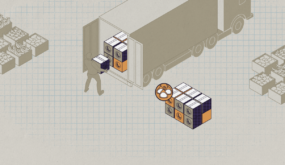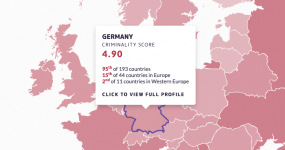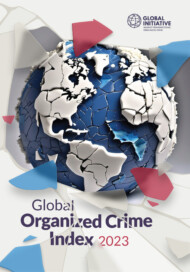On 14 June, the UEFA Euro 2024 football tournament will kick off in Munich. Over four weeks, millions of fans from around the world will flock to the German cities where matches will be played. Fans will be hoping for another Sommermärchen, or fairytale summer, the likes of which the country last experienced when it hosted the 2006 FIFA World Cup. However, will this mass influx of supporters, most of whom are expected to be male, also lead to a rise in sex trafficking to Germany?
Similar concerns were raised in the run-up to the FIFA World Cup in 2006, when it was estimated that up to 40 000 women might be trafficked into Germany – a figure widely reported in the media, but later found to be grossly inflated. There is little evidence of a link between major sporting events and increased levels of human trafficking for sexual purposes, with few exceptions. Over the course of the 2006 World Cup, authorities reported only five cases of trafficking directly linked to the tournament out of 33 criminal investigations. However, such statistics may mask the true scale of the risk.
Although an increase in sex trafficking offences could not be confirmed, German authorities did note a higher number of sex workers during the World Cup. One outreach worker in Berlin said that the World Cup had seen influxes of Eastern European sex workers, with local sex workers becoming the minority.
For this year’s tournament, some appear to have already spotted an opportunity to promote sex work alongside football. An online advertisement for a brothel near Dortmund, for example, shows a woman holding a football and inviting customers to ‘live the fairytale summer’. The brothel offers ‘all games, all goals, all girls 18+’.
Germany and sex trafficking
Germany is a source, transit and destination country for human trafficking for sexual exploitation, although the country has put in place a number of initiatives to combat it. Sex work has been legal in Germany since 2002, and stricter regulation introduced in 2016 was designed to reduce the sector’s vulnerability to traffickers and exploitation. In the US Department of State’s annual assessment on trafficking in persons, Germany is regularly ranked as a tier 1 country, which means it fully meets the ‘minimum standards for the elimination of trafficking’. Civil society also plays a key role in the prevention of human trafficking and in supporting victims.
Germany was highly responsive to the perceived risks around the 2006 World Cup, with law enforcement on alert and increased surveillance of brothels and street sex work. During the tournament, several awareness-raising campaigns were funded, emergency hotlines were put online and there was a high level of cooperation between NGOs, authorities and churches.
Nevertheless, despite such measures during a high-profile sports event, human trafficking remains a serious issue in the country. According to the 2023 Organized Crime Index, it is one of the most pervasive criminal markets in Germany. With a score of 6 out of 10, Germany ranks higher than the European average for this criminal market (5.13) and second in Western Europe, tied with France.
The legality of sex work in Germany should, in theory, act as a countermeasure to the criminal exploitation of the sector, but recent trends suggest that there are still opportunities for traffickers to exploit. Since the COVID-19 pandemic, there has been a growing trend to move sex workers off the streets into so-called ‘apartment brothels’, making their exploitation harder to detect.
Moreover, most victims of human trafficking are not officially recorded in the prostitution register. In 2022, only 16 per cent of victims of trafficking for sexual exploitation were actually registered. The city of Berlin officially reports 2 055 legally registered sex workers as of August 2023, a figure that is believed to be a third or even a quarter of the true total.
The majority of victims of trafficking for sexual exploitation have German passports, followed by Bulgarian and Romanian nationals. This mirrors the traffickers’ nationalities: according to data from 2022, these are led by German criminals, followed by Bulgarian and Romanian nationals, with roughly 85 per cent of perpetrators being male. Together with Germany, Romania is in the group of countries with the highest levels of human trafficking in Europe, as measured by the 2023 Organized Crime Index.
Sex workers from south-eastern Europe operate in an environment where the line between choice, necessity and coercion is often blurred. The German term Armutsprostitution (poverty prostitution) refers to Bulgarian, Hungarian and Romanian sex workers from low-income backgrounds who are most often found in street prostitution. Drug use is widespread among these workers and rates of sexually transmittable diseases are estimated to be high. The women often work in a culture of silence and, according to local NGOs, intimidation and fear. South-eastern European sex workers are said to be reluctant to seek help, even in medical emergencies, or to engage with local authorities.
As a result, the authorities face major difficulties in investigating cases of human trafficking and sexual exploitation, with the main obstacles being the impermeability of the sector and the difficulty in distinguishing legal sex work from sexual exploitation, and migration from human trafficking.
On the streets of Berlin
In the weeks leading up to Euro 2024, research in Berlin did not confirm an increase in the incidence of sex trafficking into Germany. One sex worker interviewed even refuted the suggested link between the upcoming tournament and increased demand for services, saying that her work was more seasonal: ‘That has nothing to do with it. The only change is in the winter – that’s when I have more clients.’ Local sex workers have not generally noticed an increase in the number of active sex workers, although this may change when millions of fans begin to arrive in the country.
Although experts argue that events like Euro are too short to make the logistical effort worthwhile, human trafficking in the continent tends to be intraregional, reducing potential logistical costs and immigration obstacles. On 14 June, flight tickets from Bucharest to Berlin are available for around €50. Not surprisingly, 90% of all victims of human trafficking within Europe are European citizens.
Given the shift in the sex industry to less visible settings, the EU’s open migration regulation and the culture of secrecy in the sector, gathering data on sex trafficking and exploitation requires a continuous research effort. The Global Initiative Against Transnational Organized Crime’s recently established Observatory on Organized Crime in Europe plans to investigate further intraregional patterns of sex trafficking.
As millions of football fans descend on the country over the course of the tournament, the signs are that demand for affordable sexual services will increase. As Germany steps up its response to organized crime, additional resources should be directed towards combating human trafficking and sexual exploitation.
This analysis is part of the GI-TOC’s series of articles delving into the results of the Global Organized Crime Index. The series explores the Index’s findings and their effects on policymaking, anti-organized crime measures and analyses from a thematic or regional perspective.
Subscribe to the GI-TOC Observatory of Organized Crime in Europe mailing list to stay updated on our upcoming publications and initiatives.
Rote Karte für Menschenhandel und sexuelle Ausbeutung
Am 14. Juni begann in München die UEFA-Fußball-Europameisterschaft. Vier Wochen lang werden Millionen von Fans aus der ganzen Welt in die deutschen Städte strömen, in denen die Spiele stattfinden. Die Fans hoffen auf ein erneutes Sommermärchen, wie es das Land zuletzt bei der FIFA-Fußball-Weltmeisterschaft im Jahr 2006 erlebt hat. Hat dieser Ansturm von Fans, von denen ein Großteil männlich sein dürfte, auch zu einem Anstieg von Menschenhandel für sexuelle Zwecke in Deutschland geführt?
Vergleichbare Sorgen hatten sich im Vorfeld der Fußballweltmeisterschaft 2006 verbreitet. Damals wurde spekuliert , dass bis zu 40 000 Frauen nach Deutschland verschleppt worden waren – eine Zahl, über die in den Medien viel berichtet wurde, die sich aber später als stark übertrieben herausstellte. Tatsächlich meldeten die Behörden bei insgesamt 33 Ermittlungsverfahren nur fünf Fälle von Menschenhandel, die in direktem Zusammenhang mit dem Turnier standen. Vor dem Hintergrund der hohen Dunkelziffer können solche Statistiken jedoch das wahre Ausmaß der Problematik verschleiern.
Obwohl ein Anstieg der Straftaten im Deliktbereich Menschenhandel nicht nachgewiesen werden konnte, wurde während der Weltmeisterschaft eine höhere Anzahl von Sexarbeiterinnen festgestellt. Nach Aussagen eines Streetworkers in Berlin habe erst die Weltmeisterschaft zu einer Zunahme osteuropäischer Sexarbeiterinnen geführt, während einheimische Sexarbeiterinnen zu einer Minderheit geworden seien.
Für die diesjährige Europameisterschaft scheinen einige bereits eine Gelegenheit erkannt zu haben, um mit Fußball für käuflichen Sex zu werben. Eine Onlineanzeige für ein Bordell in der Nähe von Dortmund zeigt beispielsweise eine Frau, die einen Fußball in der Hand hält und Kunden dazu einlädt, gemeinsam das „Sommermärchen zu erleben“. Das Bordell biete „alle Spiele, alle Tore, alle Girls 18+“ an.
Deutschland und Menschenhandel
Deutschland gilt als Herkunfts-, Transit- und Zielland des Menschenhandels zum Zwecke der sexuellen Ausbeutung, obwohl das Land zahlreiche Initiativen zu dessen Bekämpfung ergriffen hat. 2002 wurde Sexarbeit in Deutschland legalisiert. Um die Anfälligkeit des Sektors gegenüber Menschenhändlern und sexueller Ausbeutung zu reduzieren, wurden im Jahr 2016 strengere Regelungen verabschiedet. In dem jährlichen Bericht des US-Außenministeriums über Menschenhandel wird Deutschland regelmäßig als Land der Stufe 1 eingestuft, wodurch es die „Mindeststandards für die Beseitigung des Menschenhandels“ vollständig erfüllt. Hinsichtlich der Prävention des Menschenhandels und der Unterstützung der Opfer gilt die Rolle der Zivilgesellschaft ebenfalls als unerlässlich.
Im Zusammenhang mit der Fußball-Weltmeisterschaft 2006 reagierte Deutschland wachsam auf die wahrgenommenen Risiken. Strafverfolgungsbehörden waren auf Alarmbereitschaft gesetzt worden und die Beobachtung von Bordellen und Straßenprostitution wurde verstärkt. Während des Turniers wurden mehrere Sensibilisierungskampagnen geführt, Notruf-Hotlines eingerichtet und die Kooperation zwischen NGOs, Behörden sowie kirchlichen Institutionen verstärkt.
Trotz all dieser Maßnahmen ist Menschenhandel in Deutschland ein ernstes Problem geblieben. Der Index zur organisierten Kriminalität der Global Initiative against Transnational Organized Crime erfasst Menschenhandel als einen der prominentesten kriminellen Märkte des Landes. Mit einer Bewertung von 6 (von 10) wird Deutschland über dem europäischen Durchschnitt für diesen kriminellen Markt (5,13) eingeordnet und belegt zusammen mit Frankreich den zweiten Platz in Westeuropa.
Die Legalität der Sexarbeit in Deutschland soll der kriminellen Ausbeutung in diesem Sektor entgegenwirken. Die aktuellen Trends zeigen derweil, dass Menschenhändler immer noch Möglichkeiten für Ausbeutung finden können. Seit der COVID-19 Pandemie ist zu beobachten, dass Sexarbeit zunehmend von der Straße in so genannte „Wohnungsbordelle“ verlegt wird, was die Aufdeckung von Ausbeutung und verwandten Delikten schwieriger gestaltet
Die Statistiken zeigen, dass zudem die meisten Menschenhandelsopfer nicht offiziell im Prostitutionsregister auftauchen. Im Jahr 2022 waren nur 16 Prozent der Menschenhandelsopfer zur sexuellen Ausbeutung tatsächlich offiziell als Prostituierte angemeldet. Laut Angaben der Stadt Berlin waren im August 2023 2.055 Sexarbeiter*innen offiziell registriert. Vermutet wird jedoch, dass diese Ziffer nur ein Drittel oder sogar nur ein Viertel der tatsächlichen Anzahl ausmacht.
Die Mehrheit der Opfer von Menschenhandel zum Zwecke der sexuellen Ausbeutung in Deutschland besitzt einen deutschen Reisepass, gefolgt von bulgarischen und rumänischen Staatsbürger*innen. Dieses Verhältnis spiegelt sich auch in den Nationalitäten der Menschenhändler wider: Daten aus dem Jahr 2022 zeigen, dass die Statistik von deutschen Straftätern angeführt wird, gefolgt von bulgarischen und rumänischen Staatsbürgern. Nahezu 85 Prozent der Täter sind männlich. Zusammen mit Deutschland gehört auch Rumänien zu den Ländern mit der stärksten Ausprägung des Deliktfeldes Menschenhandel in Europa, gemessen am Index zum organisierten Verbrechen von 2023.
Sexarbeiterinnen aus Südosteuropa arbeiten in einem Umfeld, in dem die Grenze zwischen freier Entscheidung, Zwang und Notlage oft verschwimmt. Der Begriff Armutsprostitution in Deutschland bezieht sich vorwiegend auf bulgarische, ungarische und rumänische Sexarbeiterinnen aus wirtschaftlich benachteiligten Verhältnissen, die häufig in der Straßenprostitution tätig sind. In dieser Gruppe ist Drogenkonsum weit verbreitet und das Risiko sexuell übertragbarer Krankheiten wird als hoch eingeschätzt. Die Frauen arbeiten oft in einer Kultur des Schweigens sowie, nach Berichten lokaler NGOs, unter Einschüchterung und Angst. Es wird berichtet, dass die Betroffenen selbst bei medizinischen Notfällen zögerlich sind, Hilfe zu suchen oder sich an die örtlichen Behörden zu wenden.
Die Behörden stehen daher vor erheblichen Herausforderungen zur Aufdeckung von Menschenhandel und sexueller Ausbeutung. Die größten Hindernisse stellen die Undurchsichtigkeit des Sektors dar sowie die Schwierigkeit, legale Sexarbeit von sexueller Ausbeutung sowie legale Migration von Menschenhandel zu unterscheiden.
Auf den Straßen Berlins
In den Wochen vor dem Anpfiff der Europameisterschaft 2024 zeigten Recherchen in Berlin keine Hinweise auf eine Zunahme der sexuellen Ausbeutung und dem Menschenhandel in Deutschland. Eine befragte Sexarbeiterin wies die Vermutung zurück, dass es überhaupt einen Zusammenhang zwischen der bevorstehenden Europameisterschaft und der gestiegenen Nachfrage nach sexuellen Dienstleistungen gebe, da die Arbeit saisonabhängig sei: “Das hat nichts damit zu tun. Der einzige Unterschied ist im Winter – dann habe ich mehr Kunden.“ Örtliche Sexarbeiterinnen hatten im Vorfeld des Turniers keine Zunahme der Anzahl aktiver Sexarbeiterinnen bemerkt, obwohl sich dies ändern könnte , wenn Millionen von Fans in die Stadt strömen.
Experten argumentieren, dass Veranstaltungen wie die Europameisterschaft zu kurz seien, um den logistischen Aufwand für Menschenhändler lohnend zu machen. Allerdings ist Menschenhandel in Europa in der Regel ein intraregionales Phänomen. Dies reduziert potenzielle logistische Kosten und Einwanderungshindernisse erheblich. Am 14. Juni waren Flugtickets von Bukarest nach Berlin bereits für rund 50€ erhältlich. Daher überrascht es nicht, dass 90% aller Opfer von Menschenhandel in Europa europäische Bürger*innen sind.
Angesichts der Verlegung der Industrie der sexuellen Ausbeutung in weniger sichtbare Bereiche, der Freizügigkeit innerhalb der EU und der Geheimhaltungskultur innerhalb dieses Sektors erfordert die Erforschung von Menschenhandel und sexueller Ausbeutung weitergehende Anstrengungen. Das kürzlich von der Global Initiative Against Transnational Organized Crime eingerichtete „Europe Observatory“ für organisierte Kriminalität in Europa plant, weitere intraregionale Strukturen des Menschenhandels zu untersuchen.
Mit Millionen von Fußballfans, die während des Turniers nach Deutschland strömen, dürfte die Nachfrage nach preiswerten sexuellen Dienstleistungen voraussichtlich steigen. Angesichts der verstärkten Bemühungen Deutschlands im Kampf gegen organisierte Kriminalität bleibt zu hoffen, dass auch zusätzliche Ressourcen zur Bekämpfung von Menschenhandel und sexueller Ausbeutung bereitgestellt werden.
Diese Analyse ist Teil einer Artikelserie von GI-TOC, die sich mit den Ergebnissen des Global Organized Crime Index beschäftigt. In dieser Reihe werden die Ergebnisse des Index und ihre Auswirkungen auf die Politikgestaltung, Maßnahmen zur Bekämpfung der organisierten Kriminalität und Analysen aus einer thematischen oder regionalen Perspektive untersucht.



